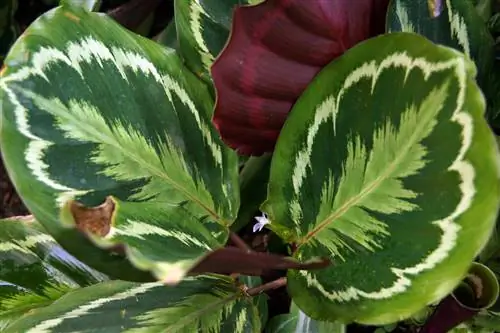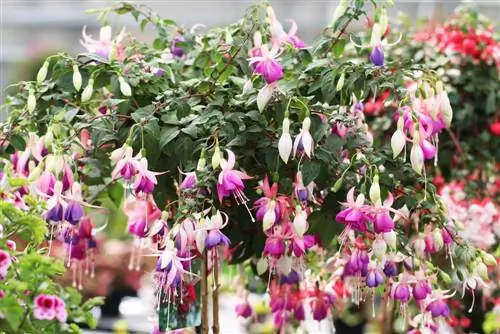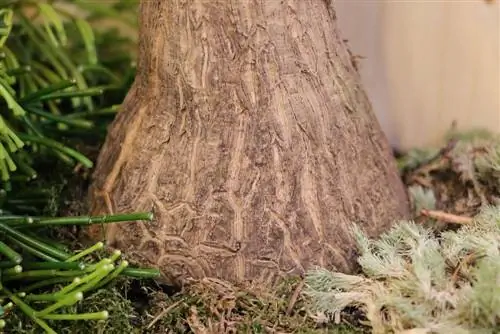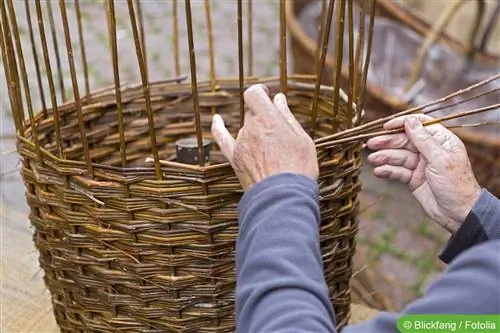- Author admin [email protected].
- Public 2023-12-17 03:39.
- Last modified 2025-01-24 12:45.
Basket marantes transform any room into an evergreen retreat. In particular, the varieties Calathea lancifolia with its lanceolate leaves and Calathea medallion with oval foliage are decoratively presented with enchanting markings. The reddish undersides of the beautiful decorative leaves are a striking gimmick. With their opulent silhouette, the tropical green plants add a charming touch to previously awkward corners of the room because they don't require a lot of light. The following care tips show you how to successfully cultivate it.
Location
The basket marant is available wherever other green plants do not want to thrive due to dim lighting conditions. In order for the exotic leaf pattern to develop in its full beauty, a certain amount of brightness is required; Under the blazing sun, the pretty patterns fade beyond recognition. Temperatures and humidity play a role in this balancing act, so an exemplary location should be as follows:
- partly shady location to light shade
- warm, at temperatures around 25 °C
- Consider minimum temperature of 18 °C
- Humidity between 70 and 80 percent
While the light and temperature conditions are not a problem, the fairly high humidity poses a challenge for the local climatic conditions. Calathea lancifolia and Calathea medallion are particularly comfortable in a warm, humid bathroom. In the living room, knowledgeable hobby gardeners use suitable aids, such as humidifiers or indoor fountains. A solution that is as simple as it is effective is to use coasters filled with stones and water.
Tip:
A daily mist of room temperature, lime-free water promotes the vitality and resistance of a marantine.
Substrate
Basket marantes like to extend their roots in a humus-rich, loose substrate. Commercially available compost-based potting soil meets these requirements perfectly. Since a slightly acidic pH value of 5.5 is desirable, add some peat or leaf mold and a handful of perlite or sand.
Watering and fertilizing
Although neither Calathea lancifolia nor Calathea medallion sink into true hibernation like our native plants, they at least reduce their consumption of water and nutrients during the cold season.
- water generously from April to October without causing waterlogging
- if the substrate surface dries, watering is required
- keep the potting soil a touch drier from November to March
- administer liquid fertilizer for green plants every 2 weeks during the growing season
- from November the time intervals will be extended to 6-8 weeks
There is no gradation in terms of the level of humidity, which is at a constant level of 70-80 percent. In the course of the heating season, the leaves need to be sprayed even more frequently.
Cutting
One of the many positive attributes is its good-natured tolerance to pruning. A basket marante can therefore be easily maintained to the desired extent. Ideally, you should carry out a topiary cut in early spring, shortly before fresh shoots appear. Withered leaves and flowers can be cleaned out at any time.
Repotting
If the roots push up through the substrate or grow out of the opening in the ground, it is time for a larger planter. The best time for repotting is in March and April, when new growth has not yet appeared. Choose a new flower pot with a slightly larger diameter, no more than 5 cm. If the new container has significantly more volume, the plant will initially strive hard for complete rooting and neglect the formation of a magnificent coat of leaves.
- To prevent waterlogging, create a drainage system made of inorganic material above the floor opening
- fill in a first layer of potting soil and press down with your fist
- Unpot the Calathea and shake off the used substrate
- Insert into the new pot and fill with soil up to 2 cm below the edge of the pot
When a basket marant is transplanted, this is an excellent opportunity to examine the root ball. Cut out anything that doesn't look plump and he althy.
Propagate
Once you have a Calathea lancifolia or a Calathea medallion in your green kingdom, there is no need to buy additional specimens, because propagation is quite uncomplicated. You have the choice of dividing or using the cutting method.
Division
Repotting in spring offers an excellent opportunity to create another basket marante in just a few simple steps. At the same time, division serves to rejuvenate the foliage plant. After you have removed the plant from the pot, take a sharp knife and cut the root ball. Each section has at least 2-3 shoots so that it can thrive independently. Place the segments in normal substrate and water generously. Considering the reduced root volume, place a plastic bag over the pot.

For the next 2-3 weeks, the plants regenerate from the strain in the warm, humid microclimate of the cover, while new roots sprout. The cover is then removed so that the green plants can be cared for like adult specimens.
Shoot cuttings
If division is not desirable or sensible, propagation by shoot cuttings serves as an adequate alternative. Shoot cuttings branch out on the sides of the stems and have at least 2 leaves. Cut suitable offshoots 2-3 mm below a leaf node to a length of 10-15 cm. You can recognize a leaf node as a slight bump in the plant tissue. How to proceed:
- fill a small pot with potting or pricking soil
- Insert half of each shoot cutting so that at least 1 leaf can be seen
- place in a greenhouse in a partially shaded window seat
- moisten the substrate with lime-free water
For rooting to take place, consistently high temperatures of around 25 °C are required over the next 4-6 weeks. The earth must not dry out at this time. As a prophylactic against mold, the mini greenhouse is ventilated daily. If there are fresh shoots on the cutting, the process is proceeding as desired.
Pests
Basket marantes prove to be largely resistant to diseases. If problems arise, cunning pests are usually behind them. Scale insects and spider mites attack houseplants, especially during the winter, because they like the dry air from the heating system. As masters of camouflage, the pests are only discovered late. If brown, rounded bumps appear on the leaves or white webs on the shoots, these are clear symptoms. How to fight the parasites:
- Isolate the infected marant immediately.
- Cut off all affected plant parts.
- Rush the Calathea overhead.
- Wipe the leaves thoroughly with a cloth soaked in alcohol.
If you avoid using chemical preparations, the following home remedy against scale insects has proven to be effective: Add 15 ml of curd soap and 15 ml of spirit to 1 liter of water and spray the plant every 3 days.
Conclusion of the editors
They make a strong appearance in every living room and office. It is no coincidence that basket marantes are the ideal foliage plants for hobby gardeners who do not want to have to deal with time-consuming care. If the central postulates of moderate lighting conditions, warm temperatures and high humidity are met, Calathea lancifolia and medallion are already very favorable. All that's missing is an adequate supply of water and nutrients, which really doesn't require a green thumb. Anyone who becomes familiar with these care tips will also be able to master uncomplicated propagation through division or shoot cuttings.
What you should know about basket marant in brief
- The Calathea lancifolia comes from the rainforests of Brazil and has long, narrow, lancet-shaped leaves.
- The leaf color is olive green at the edges, the markings are dark green, which creates a wonderful contrast.
- The Calathea medallion, on the other hand, comes from Colombia and Brazil, has rounded leaves with breathtakingly beautiful markings.
- The undersides of the leaves of both species have a reddish-purple color.
- What's interesting about the basket martens is that they put their leaves into sleeping position at night by placing them close together.
- Both species require very high humidity, which must be constantly between 60 and 80%.
- High room temperatures around 20-25 °C are also necessary if you want to achieve he althy growth.
- Unfortunately you can't avoid spraying every day.
- The ideal location for the Calathea lancifolia is light to partially shaded, while the C. medallion prefers a shady location.
- The root ball must never dry out completely, so ensure regular watering.
- Young plants are repotted into loose, humus-rich soil every February/March.
- Both species prefer slightly acidic soil, with pH values between 5.0 and 5.5.
- Peat soil mixed with coniferous and leafy soil is the optimal substrate.
- The rootstocks must also be divided as part of the repotting work.
- So that strong plants grow from the sections, all sections should have at least three leaves.
- For older plants, repotting every 2 to 3 years is sufficient.
- From the end of March to the end of September, both species are supplied with a 0.1% fertilizer solution every 14 days.
- Calathea medallion in particular is always happy when you wipe its beautiful, large leaves with a soft, damp cloth.
- Tempered, soft water is suitable for watering and spraying. Rainwater would be ideal, but it is not always available.
- Tap water should be boiled, or at least left to stand overnight.
- Pests are not to be expected, provided optimal care is provided.
- If the air is too dry or inadequate watering, an infestation by spider mites and scale insects can be observed.
- Pest control is carried out as gently as possible. Scale insects can easily be collected by hand.
- If spider mites are infested, use biologically based pesticides.






